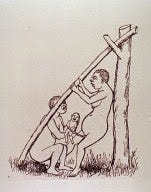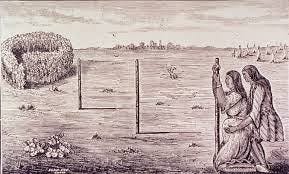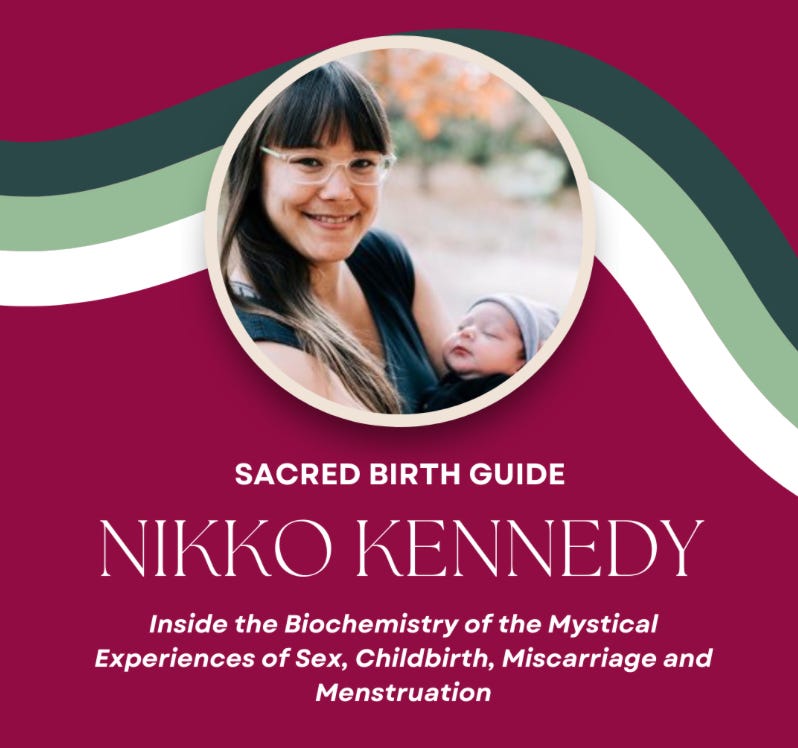Optimize your natural birth prep for the possibility of transcendent experiences
How do so many women overcome the material limitations of childbirth and transmute their suffering into divine wisdom? Are you, or could you be one of them?

The birthing process, though relatively short compared with an entire lifespan, teaches us the acute importance of minding the circadian and quantum environment in any given moment.
The warm sun kissed the earth to consecrate thy birth, and from his close embrace thy radiant face sprang into sight, a blossoming delight.
– Sarah Orne Jewett
What would an “ideal” birth prep look like?
While the typical debate here tends to revolve around nutrition, exercise, mindset, home vs hospital/birth center, and—lately—assisted vs unassisted, today I’d like to talk about things from a slightly different standpoint that allows us to improve all birth options: how can we re-embrace the natural world as a feature of any birthing preparation in order to better support the labor process?
And then a little later in this post, I’ll talk about why as well the research that supports this thesis.
This post is a quick introduction to the topics that will make up my class that will be included in Indie Birth’s new Sacred Birth Certificate program.
I’m really excited to bring this information to the world.
The way our babies are born matters!
And through the elements I will be teaching out, we can offer birthing families the best possible chance of not just a healthy birth, but a transcendent birth.
An awe-inspiring birth.
A birth that, for the family, seems to defy the limits of the material world.
Here’s where you can get access:
Join us at the link above and learn how to transmute labor pain, get out of body and out of time, drop into flow state, and experience divine communications through a body and environment that are harmoniously tuned to support the light-activated biophysical markers seen in people who experience these types of transcendent experiences in labor as well as other heightened times of life, including miscarriage, menstruation, while making love and even in everyday activities such as in song and dance.
And now, I’d like to share a little bite more about this topic and the themes and knowledge I have woven together around this theme.
How we used to support birth (before hospitals came into fashion):
Traditionally, people have handled birth in many ways.
A midwife could travel to care for families in their own homes; this was historically a very common way to support birth.
Some cultures built temporary outdoor structures for birthing families, away from the primary living space.
In other places, women traveled to the midwife’s home rather than having the midwife travel to them1.
There’s a great resurgence happening in the homebirth movement—which I love (I’ve had 3 home births and 1 hospital birth so far and the difference in mood is astounding).
But to speak honestly, the majority of families travel to dedicated birth centers operated by multiple staff members. These can be freestanding birth centers or hospital based birth centers.
Something unique about modern birthing centers is the staff are unrelated to eachother other than by work (ie, the familial connections that were common in the past are no longer common).
We can also recognize benefits of birthing away from home for families such as:
-privacy (sometimes it’s easer for the mother to focus when she’s away from her usual companions and surroundings—I’ve known women who had very long labors, only to suddenly birth when certain members of her “team” stepped away for a few minutes)
-cleanliness (a good birth team can clean up a mess quickly, but in more resource-poor settings with limited running water it can make sense to birth away from the primary dwelling)
-ritual (some women need a physical separation from their everyday life in order to let go of their everyday mental state so they can enter their birthing trance)
As well for birth workers, who, with a good birth center, experience:
less commuting
the ability to serve multiple clients at a time
not having to learn the layout and facilities of a new location for each birth
and other benefits of a space managed and cared for in their own normal routine and in a way that allows birth care professionals to feel the most safe, comfortable and able to release oxytocin and other beneficial hormones and neurotransmitters2.
Yes, the hormonal state of the birth workers themselves also influence the likelihood of different outcomes for the birthing family!
So, as I said earlier, I’m not creating this body of work to further the tired home vs hospital debate.
And the same could easily be said for the newer, but still tiresome, assisted vs unassisted debate.
Since high-risk mother-baby dyads are the most likely to opt for care and for that care to be provided outside of their own home3, institutional design would ideally be working with the most state-of-the art equipment to avoid the problems of low circadian stimulation and high exposure to nnemfs that can exacerbate complications of pregnancy.
Thus, institutional birthing spaces such as free standing birth centers and hospital-based birth centers serving high-risk women (as well as women who simply feel safer with medical equipment and staff at hand) should be optimizing towards Nature as the gold standard.
And of course home-birthing families also benefit from making these changes.
What I am sharing in my class and as a whole with Brighter Days, Darker Nights can be applied in any setting.
Design choices that support optimal hormonal flows in pregnancy labor include:
- opening windows to allow sunlight in
- private walking paths, gardens, labyrinths, and courtyards
- grounded sheets for beds
- grounded incubators for babies that need extra support after birth
- red light therapy devices for pain management and to support the mitochondrial health of mother-baby
- lighting options that support the needs of the moment (amber/red for physiological processes, white for emergency processes)4
The science is exploding about how beneficial it is for people to get closer to the natural light cycles and the natural electrical field of the planet.
Yes, home and nature are often—maybe even most often—the best possible place for birth to happen.
Specialized birthing facilities can also be the best possible place for birth to happen, and especially if they are designed with these principles of Nature in mind.
The birthing process, though relatively short compared with an entire lifespan, teaches us the acute importance of minding the circadian and quantum environment in any given moment.
-Nikko Kennedy
In the future we may even recreate the whole construct of birth centers into a new format entirely, such as a “birth sanctuary” as envisioned at Indie Birth and the many others who respect the need to reincorporate the Sacred aspects of Nature into modern birthing culture.
In this devotional future, all birthing spaces would allow families to access the outdoors, firstly and most importantly because lack of access to Nature is the number one cited complaint from birthing women and midwives alike about modern birth suites.
Secondarily, science validates the need for Nature to be part of the birthing process.
Sunlight stimulates the circadian rhythm, serotonin, cellular melatonin, endorphins, endocannabinoids, neurotransmitters and other chemicals that enhance the mother’s wellbeing and may increase the likelihood she has a TRANSCENDENTAL experience in labor.
Light, Hormones, Neurotransmitters, and Transcendent Birth Experiences by Nikko Kenney for Indie Birth
I’m so excited for my upcoming class for Indie Birth’s Sacred Birth program.
Join us and learn how to overcome pain, get out of body and out of time, drop into flow state, and experience divine communications through a body and environment that are harmoniously tuned to support the light-activated biophysical markers seen in people who experience these types of transcendent experiences.
You can apply this wisdom in any birth setting and at any risk level—as well as outside of birth altogether.
The program’s modules are geared toward both families and practitioners, so you can be sure to find support at the right level.
Enrollment has been extended until Oct. 19th, 2024. See you at the opening ceremony on October 20th? You’ll be learning from 15 of the world’s leading voices for honoring the sacred & divine in the birth processes.
Nishizaka, A. Hand Touching Hand: Referential Practice at a Japanese Midwife House. Hum Stud 30, 199–217 (2007). https://doi.org/10.1007/s10746-007-9059-4
Hammond, A., Foureur, M., Homer, C. S., & Davis, D. (2013). Space, place and the midwife: exploring the relationship between the birth environment, neurobiology and midwifery practice. Women and birth : journal of the Australian College of Midwives, 26(4), 277–281. https://doi.org/10.1016/j.wombi.2013.09.001
Sands, G., Evans, K., Spiby, H., Eldridge, J., Pallotti, P., & Evans, C. (2023). Birth environments for women with complex pregnancies: A mixed-methods systematic review. Women and birth : journal of the Australian College of Midwives, 36(1), 39–46. https://doi.org/10.1016/j.wombi.2022.04.008
Stine Louring Nielsen. Light Affects, Towards a Body-sensory Approach in Lighting Design. Proceedings of the 4th International Congress on Ambiances, Alloaesthesia: Senses, Inventions, Worlds, Réseau International Ambiances, Dec 2020, e-conference, France. pp. 132-137, https://hal.science/hal-03220282/






